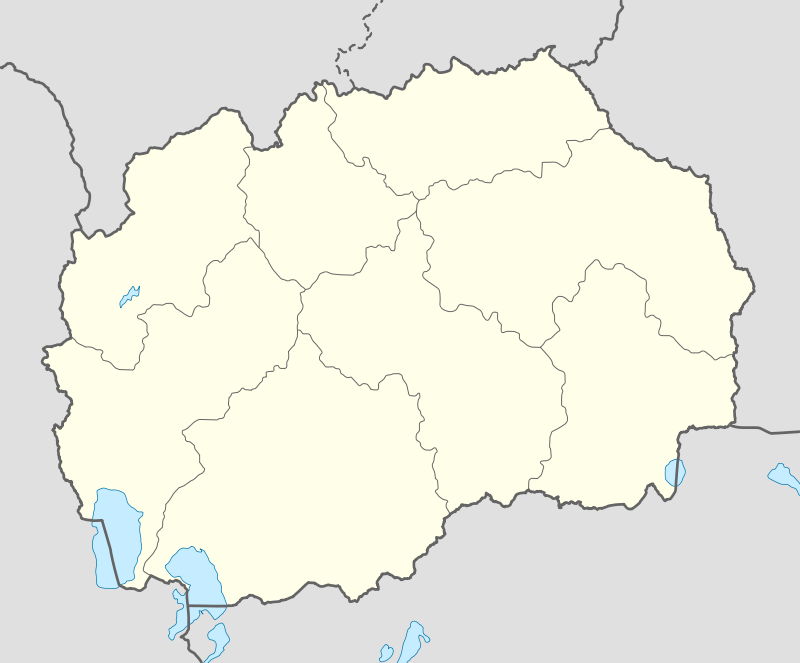Ostrec
| Ostrec | |
|---|---|
| Village | |
| Острец | |
 Ostrec Location within Republic of Macedonia | |
| Coordinates: 41°02′N 21°16′E / 41.033°N 21.267°ECoordinates: 41°02′N 21°16′E / 41.033°N 21.267°E | |
| Country | Republic of Macedonia |
| Municipality | Bitola municipality |
| Statistical region | Pelagonia Statistical Region |
| Population (2002) | |
| • Total | 229 |
| Time zone | UTC+1 (CET) |
| • Summer (DST) | UTC+2 (CEST) |
| Car plates | BT |
| Website | . |
Ostrec (Macedonian Cyrillic: Острец; Albanian: Ostrec) is a village in the municipality of Bitola, Republic of Macedonia. The village is about 12 kilometers away from Bitola, Macedonia.
Culture
Ostrec has traditionally and exclusively been populated by Ghegs, a northern subgroup of Albanians and speak the Gheg Albanian dialect,[1][2][3] similar to the Matjan and Dibran Geg subdialects.
Demographics
Due to emigration in the 1960-1970s, a sizable diaspora from the village exists in the mainly Western Suburbs of Melbourne, Australia.[4] As well as a very large number have settled in Chicago, Florida and New York, U.S., with a smaller number in Toronto, Canada.
Those settlements took place generally after the Second World War starting in the 1950s, '60s, continuing through the '70s, '80s, and beyond, However a very large number of Albanians from Ostrec immigrated in the early 1900s to Turkish cities such as Izmir and Istanbul. Other places that people from Ostrec have settled are central Albania, Tirana and Kavaja as well as the Village of Kalush near Kavaja.
According to the 2002 census, the village had a total of 229 inhabitants.[5] Ethnic groups in the village include:[5]
- Albanians 228
- Macedonians 1
References
- ↑ Indogermanische Gesellschaft (1929). Indogermanisches Jahrbuch, Vol. 13. Karl J. Trübner. p. 183. "Monastir (Bitol) auch für das Studium des Alb. geeignet: Ostrec (11 km von Monastir), Zlokućani haben geg., Dihovo, Bratindol, Magarevo, Ramna, Kažani, Dolenci, Lera, Crnovec, Drevenik, Murgašovo tosk. Bevölkerung. Die tosk."
- ↑ Jusufi, Lumnije (2010). "Eine zentralgegische Sprachinsel im toskischen Sprachareal von Manastir". In Demiraj, Bardhyl. Wir sind die Deinen: Studien zur albanischen Sprache, Literatur und Kulturgeschichte, dem Gedenken an Martin Camaj (1925-1992) gewidmet. Otto Harrassowitz Verlag. p. 282. ISBN 9783447062213.
- ↑ Godišen zbornik (1969). Volumes 17-18. Univerzitet vo Skopje. Geografski institut. p. 171. "Чисто албански села сега се: Арматуш, Кишава, Острец, Злокуќани, Снегово, Старо Змирново, Саждево, Јакреново, Борино, Норово, Древеник. При ослободувањето од турското владеење во 1912 г. оваа област имала повеќе чисто албански села."
- ↑ "After World War II". Immigration Museum. Retrieved 30 November 2015. "Albanian migration in the wake of World War II is intimately connected with the turbulent political, social and economic conditions of the homelands: Albania, Kosova, Macedonia and Montenegro. Following the war, the establishment of a Stalinist dictatorship in Albania and a centralised communist regime in former Yugoslavia had profound and deeply tragic consequences. A small number of refugees from Albania, and especially Albanians from the Prespa region in south-western Macedonia, were resettled in Australia. Sharing a common dialect – Toskë, one of the major southern Albanian dialects – and a long history of intermarriage and cultural exchange with Albanians from the Korçë region, they found a ready sense of community and solidarity with the early kurbetxhi in Victoria and elsewhere in Australia. With mass migration to Australia during the 1960s and 1970s, the Prespa Albanians and those from the nearby villages of Këshavë and Ostrec formed a large proportion of the Albanian community in Australia, numbering 5,401 in 1991. The majority of these mostly Muslim Albanians settled in Victoria, principally in Melbourne's industrial, working-class suburbs of Dandenong, Footscray, Yarraville, Altona, St Albans, Preston, Thomastown and Lalor."
- 1 2 Macedonian Census (2002), Book 5 - Total population according to the Ethnic Affiliation, Mother Tongue and Religion, The State Statistical Office, Skopje, 2002, p. 70.
External links
| Wikimedia Commons has media related to Ostrec. |